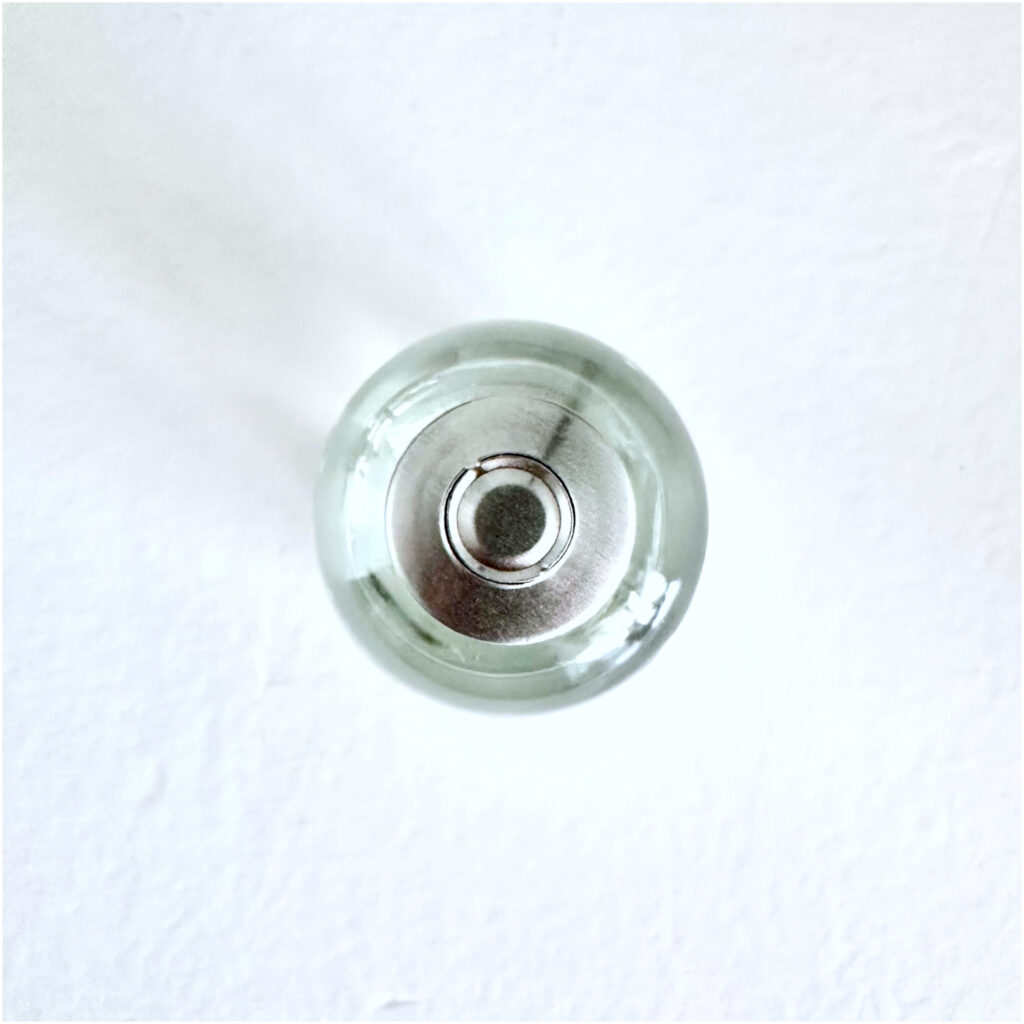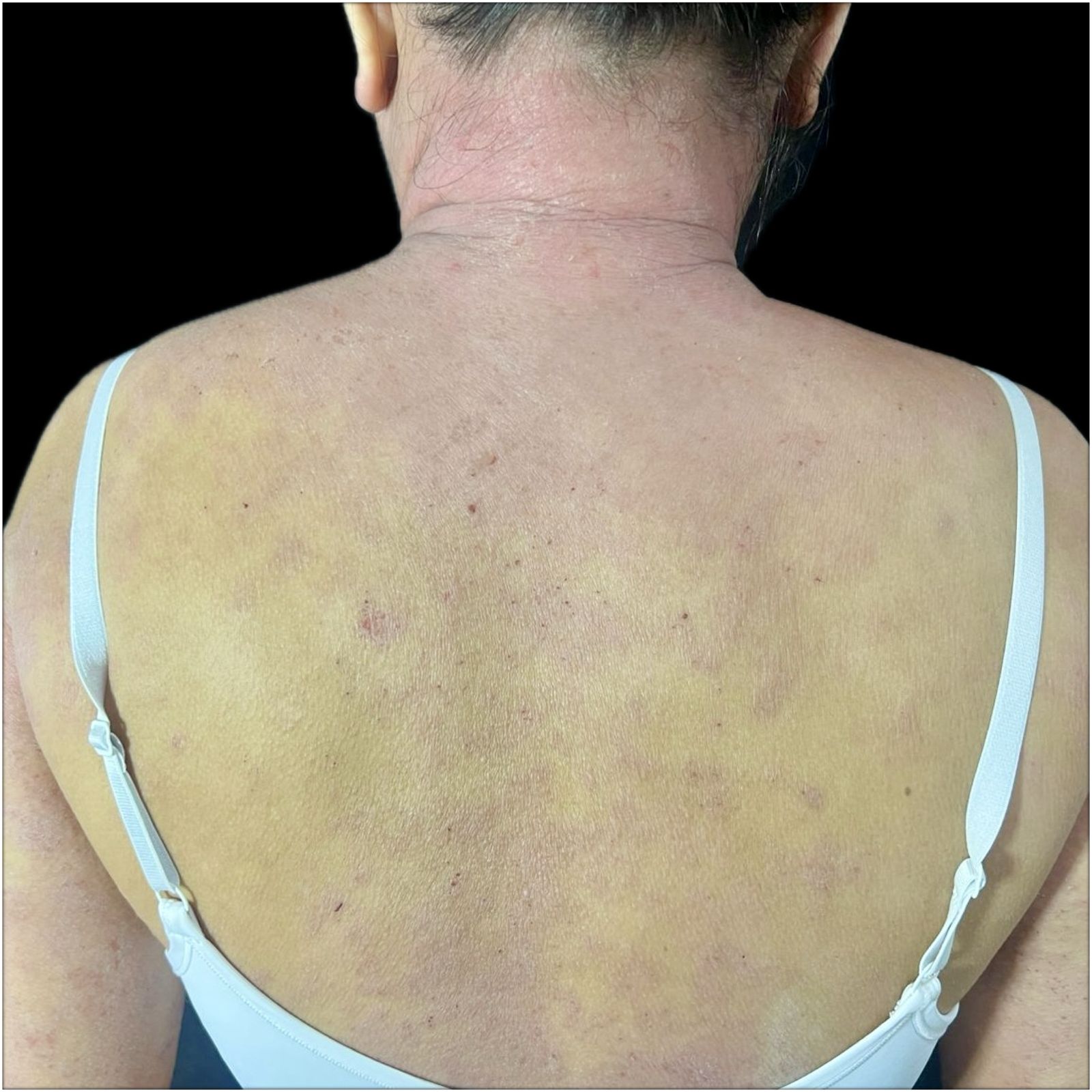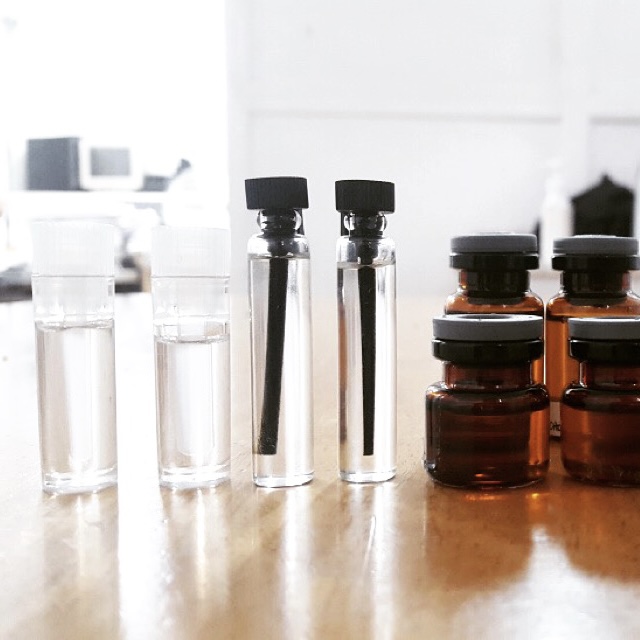Not An Allergen
Estrogen
This sex hormone is produced by our bodies and plays an important role in human reproductive systems. It can also be taken orally, via transdermal patch, gel, spray, cream, or injection. While there is a condition called estrogen dermatitis and some case reports of systemic contact dermatitis to orally taken estrogen, these are rare. The hormone itself is not known to be a regular cause of contact dermatitis.
Risk of photosensitivity (a stronger or unusual reaction to rays from the sun or indoor lights): while also not very common, topically applied estrogen is included in a comprehensive list of drugs known to cause photosensitivity, photo-allergies, and photocontact dermatitis. Symptoms can include redness (like a sunburn), rashes, blisters, oozing lesions, itching, and pain. Post-inflammatory hyperpigmentation frequently follows.
Contact dermatitis that does occur when using estrogen products seems mostly to be caused by allergens in the materials of the patch (one study notes “approximately 20% of patients using transdermal estradiol may complain of adverse cutaneous side effects”) or inactive ingredients in the gel or cream.
Some top contact allergens to watch out for in patches:
- The glue of the patch’s adhesive
- Epoxy resin in the patch’s backing
- Acrylates
- Rubbers and related materials
- Propylene glycol
Some gels can also contain propylene glycol.
Some creams can contain propylene glycol and other allergenic preservatives like parabens. Other estrogen creams that position themselves as “natural” can contain many more top contact allergens such as fruit and flower extracts, vitamin E, and citruses. Note that many natural substances are proven contact allergens, enough so that a recent study in the Journal of Drugs in Dermatology states, “We emphasize the misconception of clean, natural, organic, and vegan to equal safe … Many naturally derived ingredients are the cause of dermatitis.” Opt for validated hypoallergenic and use your patch test results to guide you.
Common inactive ingredients of sprays tend to not be contact allergens, namely alcohol, octisalate, and purified water.
Patients who react to estradiol or estriol patches, gels, or creams may be candidates for sprays or oral or injectable options. Ask your gynecologist and dermatologist. Especially if you have a history of sensitive skin, a patch test can help you and your doctors decide on the best option for you.
Some other tips that can help improve safety and comfort for sensitive skin:
- Perimenopause and menopause can lead to skin changes, including dry, thinner skin which can also lead to increased sensitivity and an itchy skin feeling (or actual itching from irritations or allergic reactions due to increased skin sensitivity), acne, and less collagen. Learn more tips on how to manage the safety, health, and comfort of skin in perimenopause and menopause here.
- Use fragrance-free, dye-free, paraben-free, preservative-free, comedogen-free, allergen-free skincare, hair and body products, and makeup — skin safe estrogen products can help reduce the risk of reactions to them in particular but thinner skin is more sensitive and could be more prone to reactions from other products.
- You might want to layer moisturizers for comfort and barrier protection: start with any VMV moisturizer and follow with Know-It-Oil virgin coconut oil. On very dry days, follow with Boo-Boo Balm.
- Add a physical skin barrier like Skintangible, Stay-On-Point! or Armada Post-Procedure that also protects against outdoor and indoor light (hyperpigmentation can be more of a concern in perimenopause and photosensitivity is a risk when taking estrogen).
- Barrier-compromised skin can also be more prone to opportunistic microbes: almost all VMV products use microbiome-friendly monolaurin or virgin coconut oil, which could be helpful in managing such issues.
Subscribe to VMVinSKIN.com and our YouTube channel for more hypoallergenic tips and helpful “skinformation”!
If you have a history of sensitive skin…
…don’t guess! Random trial and error can cause more damage. Ask your dermatologist about a patch test.
To shop our selection of hypoallergenic products, visit vmvhypoallergenics.com. Need help? Ask us in the comments section below, or for more privacy (such as when asking us to customize recommendations for you based on your patch test results) contact us by email, or drop us a private message on Facebook.
For more:
- On the prevalence of skin allergies, see Skin Allergies Are More Common Than Ever.
- For the difference between irritant and allergic reactions, see It’s Complicated: Allergic Versus Irritant Reaction.
- For the difference between food, skin, and other types of reactions: see Skin & Food Allergies Are Not The Same Thing.
- On the differences between hypoallergenic, natural, and organic, check out Is Natural Hypoallergenic? and this video in our YouTube channel.
- To learn about the VH-Rating System and hypoallergenicity: What Is The Validated Hypoallergenic Rating System?
Main References:
Regularly published reports on the most common allergens by the North American Contact Dermatitis Group and European Surveillance System on Contact Allergies (based on over 28,000 patch test results, combined), plus other studies. Remember, we are all individuals — just because an ingredient is not on the most common allergen lists does not mean you cannot be sensitive to it, or that it will not become an allergen. These references, being based on so many patch test results, are a good basis but it is always best to get a patch test yourself.
- Kaur G, Woodruff CM, Botto N. Life after patch testing: Allergic contact dermatitis caused by propylene glycol in Vivelle transdermal estradiol patch. JAAD Case Rep. 2021 Jan 12;9:34-35.
- Corazza M, Mantovani L, Montanari A, Virgili A. Allergic contact dermatitis from transdermal estradiol and systemic contact dermatitis from oral estradiol. A case report. J Reprod Med. 2002 Jun;47(6):507-9.
- Jenerowicz D, Polańska A, Olek-Hrab K, Silny W. Skin hypersensitivity reactions to transdermal therapeutic systems–still an important clinical problem. Ginekol Pol. 2012 Jan;83(1):46-50.
- Fukayama M, Asano Y, Shinozaki-Ushiku A, Sato S. Estrogen dermatitis: Case report and examination of estrogen receptor-β in the skin. J Dermatol. 2019 Mar;46(3):263-266.
- Hofmann GA, Weber B. Drug-induced photosensitivity: culprit drugs, potential mechanisms and clinical consequences. J Dtsch Dermatol Ges. 2021 Jan;19(1):19-29.
- Oakley AM, Badri T, Harris BW. Photosensitivity. 2023 Aug 8. In: StatPearls [Internet]. Treasure Island (FL): StatPearls Publishing; 2025 Jan–.
- Snyder A, Schiechert RA, Zaiac MN. Melasma Associated with Topical Estrogen Cream. J Clin Aesthet Dermatol. 2017 Feb;10(2):57-58. Epub 2017 Feb 1.
- Urban K, Giesey R, et al. A Guide to Informed Skincare: The Meaning of Clean, Natural, Organic, Vegan, and Cruelty-Free. J Drugs Dermatol. 2022 Sep 1;21(9):1012-1013.
- DeKoven JG, Warshaw EM, Reeder MJ, Atwater AR, Silverberg JI, Belsito DV, Sasseville D, Zug KA, Taylor JS, Pratt MD, Maibach HI, Fowler JF Jr, Adler BL, Houle MC, Mowad CM, Botto N, Yu J, Dunnick CA. North American Contact Dermatitis Group Patch Test Results: 2019-2020. Dermatitis. 2023 Mar-Apr;34(2):90-104. doi: 10.1089/derm.2022.29017.jdk. Epub 2023 Jan 19. PMID: 36917520.
- Uter W, Wilkinson SM, Aerts O, Bauer A, Borrego L, Brans R, Buhl T, Dickel H, Dugonik A, Filon FL, Garcìa PM, Giménez-Arnau A, Patruno C, Pesonen M, Pónyai G, Rustemeyer T, Schubert S, Schuttelaar MA, Simon D, Stingeni L, Valiukevičienė S, Weisshaar E, Werfel T, Gonçalo M; ESSCA and EBS ESCD working groups, and the GEIDAC. Patch test results with the European baseline series, 2019/20-Joint European results of the ESSCA and the EBS working groups of the ESCD, and the GEIDAC. Contact Dermatitis. 2022 Oct;87(4):343-355. doi: 10.1111/cod.14170. Epub 2022 Jun 24. PMID: 35678309. https://pubmed.ncbi.nlm.nih.gov/35678309/
- DeKoven JG, Silverberg JI, Warshaw EM, Atwater AR, et al. North American Contact Dermatitis Group Patch Test Results: 2017-2018. Dermatitis. 2021 Mar-Apr 01;32(2):111-123.
- DeKoven JG, Warshaw EM, Zug KA, et al. North American Contact Dermatitis Group Patch Test Results: 2015-2016. Dermatitis. 2018 Nov/Dec;29(6):297-309.
- DeKoven JG, Warshaw EM, Belsito DV, et al. North American Contact Dermatitis Group Patch Test Results 2013-2014. Dermatitis. 2017 Jan/Feb;28(1):33-46.
- Warshaw, E.M., Maibach, H.I., Taylor, J.S., et al. North American contact dermatitis group patch test results: 2011-2012. Dermatitis. 2015; 26: 49-59.
- W Uter et al. The European Baseline Series in 10 European Countries, 2005/2006–Results of the European Surveillance System on Contact Allergies (ESSCA). Contact Dermatitis 61 (1), 31-38.7 2009.
- Wetter, DA et al. Results of patch testing to personal care product allergens in a standard series and a supplemental cosmetic series: An analysis of 945 patients from the Mayo Clinic Contact Dermatitis Group, 2000-2007. J Am Acad Dermatol. 2010 Nov;63(5):789-98.
- Warshaw EM, Buonomo M, DeKoven JG, et al. Importance of Supplemental Patch Testing Beyond a Screening Series for Patients With Dermatitis: The North American Contact Dermatitis Group Experience. JAMA Dermatol. 2021 Dec 1;157(12):1456-1465.
- Verallo-Rowell VM. The validated hypoallergenic cosmetics rating system: its 30-year evolution and effect on the prevalence of cosmetic reactions. Dermatitis 2011 Apr; 22(2):80-97.
- Ruby Pawankar et al. World Health Organization. White Book on Allergy 2011-2012 Executive Summary.
- Misery L et al. Sensitive skin in the American population: prevalence, clinical data, and role of the dermatologist. Int J Dermatol. 2011 Aug;50(8):961-7.
- Warshaw EM1, Maibach HI, Taylor JS, Sasseville D, DeKoven JG, Zirwas MJ, Fransway AF, Mathias CG, Zug KA, DeLeo VA, Fowler JF Jr, Marks JG, Pratt MD, Storrs FJ, Belsito DV. North American contact dermatitis group patch test results: 2011-2012.Dermatitis. 2015 Jan-Feb;26(1):49-59.
- Warshaw, E et al. Allergic patch test reactions associated with cosmetics: Retrospective analysis of cross-sectional data from the North American Contact Dermatitis Group, 2001-2004. J AmAcadDermatol 2009;60:23-38.
- Marks JG, Belsito DV, DeLeo VA, et al. North American Contact Dermatitis Group patch-test results, 1998 to 2000. Am J Contact Dermat. 2003;14(2):59-62.
- Warshaw EM, Belsito DV, Taylor JS, et al. North American Contact Dermatitis Group patch test results: 2009 to 2010. Dermatitis. 2013;24(2):50-99.
- Verallo-Rowell V. M, Katalbas S.S. & Pangasinan J. P. Natural (Mineral, Vegetable, Coconut, Essential) Oils and Contact Dermatitis. Curr Allergy Asthma Rep 16,51 (2016) . https://doi.org/10.1007/s11882-016-0630-9.
- de Groot AC. Monographs in Contact Allergy, Volume II – Fragrances and Essential Oils. Boca Raton, FL: CRC Press Taylor & Francis Group; 2019.
- De Groot AC. Monographs in Contact Allergy Volume I. Non-Fragrance Allergens in Cosmetics (Part I and Part 2). Boca Raton, Fl, USA: CRC Press Taylor and Francis Group, 2018.
- Zhu TH, Suresh R, Warshaw E, et al. The Medical Necessity of Comprehensive Patch Testing. Dermatitis. 2018 May/Jun;29(3):107-111.
Want more great information on contact dermatitis? Check out the American Contact Dermatitis Society, Dermnet New Zealand, the Contact Dermatitis Institute, and your country’s contact dermatitis association.

Laura is our “dew”-good CEO at VMV Hypoallergenics and eldest daughter of VMV’s founding dermatologist-dermatopathologist. She has two children, Madison and Gavin, and works at VMV with her family and VMV’s signature “skinfatuated, skintellectual, skingenious” team. In addition to saving the world’s skin, Laura is passionate about health, cultural theory, human rights, happiness, and spreading goodness (like a VMV cream)!







